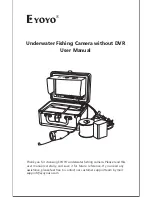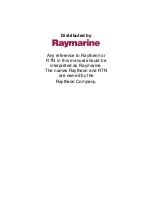
4-AAA alkaline Batteries
7.1 FISHING AT THE BOAT
-9-
7 FISHING AT THE BOAT OR ICE
fig.14
CORRECT
INCORRECT
7.2 FISHING ON ICE
45 degrees
-10-
-11-
Power Requirement:
Measure Units: Feet and meters
Sensor Beam Angle:
Depth Range Max : 328feet (100M)
-12-
Depth Range Min : 2feet (0.7M)
8 Product specification:
Display :
TN/ANTI-UV LCD
Backlighting :
Green LED
Operational Temperature:-4F to 158F (-20C—70C)
4)Stainless Wing Nut
5)Neck strap
-15-
-16-
9 Attachments:
1)Round Transducer with 25ft Cable
2)Transducer Adapter
3)Stainless Bolt
-13-
-14-
fig.15
fig.16
fig.9
fig.10
fig.11
6, FIXING SONAR
SENSOR
fig.8
fig.12
fig.13
Use the fish Depth Indicator to
measure the fish s depth from
the sonar sensor (figure 8).
This can be done by dividing
the depth reading by 10.This
number represents the value of
each box.
(Example, the depth is 200
feet, the fish symbol appears in
th5th box from the top. This
means the is100feet from the
surface)
6.1
Pull out the rubber
stopper, adjust float so that it is
7 to 10inches from the sensor,
or at your desired depth.
Replace the rubber stopper by
pressing it firmly into the float.
The Sensor float must be
adjusted so that it is a minimum
of 7 inches away from the
sensor (Figure 9).
6.2
Toss the sonar
sensor and float
assembly into water at
your desired fishing
location.
To toss, place the sonar
sensor and float in your
hand, and pitch
underhand. Do not throw
the sensor by the cable
as this will cause
unrepairable damage.
Before tossing, be
certain that the cable is
free from tangles and is
not wrapped around
anything.
6.3
Your fish finder includes a combination
adapter, mounting bracket for the sonar sensor (figure
10).
The Adapter includes mounting taps so that you can
attach it to any flat surface or boat hull (figure 11) and
appropriate rod, The Adapter is removable and
adjustable up to 180 Degrees.
6.4
Use a pole to guide the sonar sensor to a
desirable position (Figure12) or add floats on the
cable to float on the water (Figure 13)
NOTE
:
If depth readings appear as --- while using one of
these methods, place the sonar sensor directly in the
water to verity that the fish finder is operating
properly.
If it operates properly while directly in the water,
reposition the sensor in a new location in the hull,
and repeat methods A, B, These methods DO NOT
work on all hulls and you may have to place the
sensor directly in the water for proper operation.
To achieve the best performance for ice fishing, it is highly
recommended that you cut a holethrough the ice and place
the sonar sensor directly in the wate(Figure 15).If you
would like to check the areafor depth or fish before cutting
the hole.
Clear away snow to expose the ice surface, making sure
the surface is smooth.
Place a small amount of liquid water on the ice and set
the sonar sensor on the waterallowing the unit to freeze
to the ice (Figure 16 ).
If there are any air pockets between the sonar senor and
ice, or the water below the
ice, the unit will not work properly and will require you to
try another spot, or cut ahole in the ice to use.
NOTE
:
* To remove the sonar sensor from the frozen ice,
gently tap sonar sensor at the base with your hand. If
it will not come loose, spray a small amount of water
on the ice surface around the base and repeat step 4
until the sonar sensor is easily removed.
Never use a blunt to strike the sonar sensor as this
may cause to the sensitive internal electronics.
* Cold weather is extremely hard on the electrical
components within the display housing. It is
suggested that you keep the unit in temperatures
above 0 degrees Fahrenheit (-17 degrees Celsius)
during operation.
*Remove the batteries from the fish finder to prevent
battery leakage and corrosion.
Clean the sonar sensor and cable with fresh water
and dry-off before storing .Do not submerge and/or
spray the fish finder screen/housing with water or
use chemicals to clean.
7.1.1 Toss the sensor and float into the water as per the
previous instructions.
7.1.2 Attach the adapter to the boat hull using the
mounting tabs.
7.1.3 “shoot –Thru” the hull of a boat.
Place the sonar sensor in 1 inches of water against the
hull bottom.
Or coat the face of the sonar sensor with petroleum jelly
and press it against the hull bottom with a twisting
motion.
NOTE
:
*Incorrect to use . Do not allow the cable
to sink to the bottom as it may become
entangled in debris {Figure14}
* It is float that can be removed as
follows, If you find that you do not have a
need , Remove the rubber stopper from
the cable by siding the safety strap
toward the plug and gently working it
over plug.




